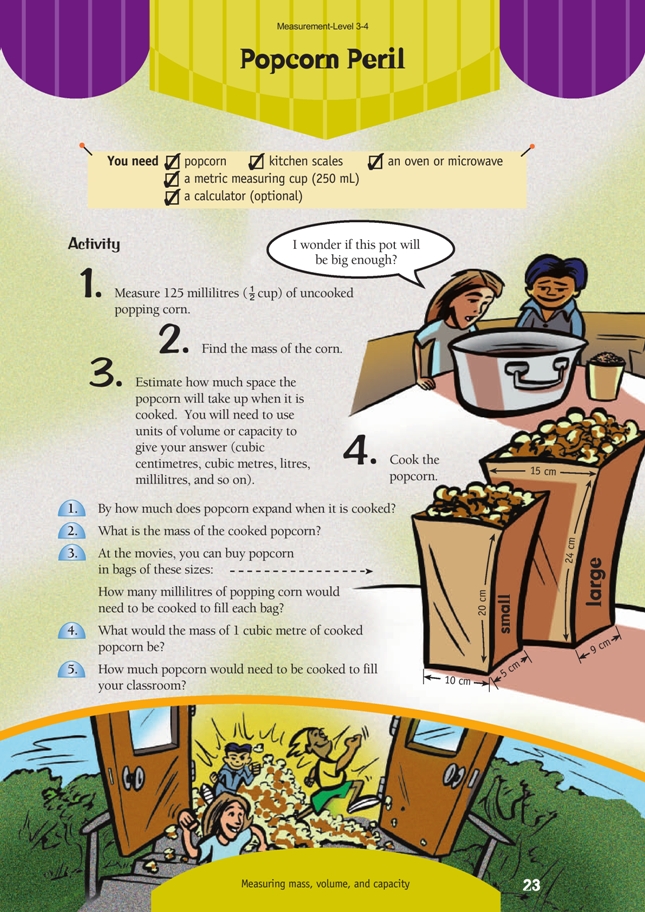This is a level 3 measurement activity from the Figure it Out series.
A PDF of the student activity is included.
Click on the image to enlarge it. Click again to close. Download PDF (512 KB)
find volume of cuboids
measure mass
popcorn
FIO, Level 3-4, Measurement, Popcorn Peril, page 23
calculator (optional)
Step 1: Encourage the students to measure as accurately as possible.
Step 2: The students are more likely to get a variety of answers, but most results will be within 10 grams of 125 grams. The class could display their results in a stem-and leaf graph in order of size and then discard any obvious outliers. They can then find an average measure. This could be the median (middle) result, the mode (most
frequent) result, or the mean result. The mode might be a good one to choose as
the class example for the mass of 125 millilitres of popcorn.
Step 3: Discuss with the class how much they think popcorn expands when it cooks. Draw on the experience of students who have cooked popcorn.
Next, discuss with the class what unit of measurement they will use for this step.
One millilitre of water has the same volume as 1 cubic centimetre (1 cm3), so if the
students choose to use cubic centimetres, they can estimate the volume of popcorn
in millilitres (or cups that are converted to millilitres) and then convert this amount
to cubic centimetres.
Step 4: Discuss with the class safe methods to cook popcorn.
In question 1, the students will have to measure cooked popcorn in the same unit in which the uncooked popcorn was measured in step 3 so that they can compare like with like. The answer can be expressed in a number of ways. Additive thinkers may say: “The popcorn increased by 2 375 millilitres. It is now 2 500 millilitres.” Proportional thinkers may say: “The popcorn is 20 times bigger.” Ask the students to explain why these statements mean the same thing. Then encourage them to give their answers as a proportion, for example: “My popcorn increased by about 20 times.”
The students may need access to a calculator because the growth proportion is unlikely to be a simple number.
The students can approach question 3 in several ways. They will need to use their answers from question 1. First, they need to calculate the volume of popcorn in the small and large bags. The small bag holds 1 000 millilitres (or 1 000 cm3 or 1 litre) and the large bag holds 3 240 millilitres. Some students may then use the proportion from question 1 to find the amount of uncooked popcorn needed: “As the cooked popcorn was 20 times bigger than the uncooked, I divided 1 000 millilitres by 20. So 50 millilitres of uncooked popcorn is needed to make the litre.”
Other students may use a table showing amounts of uncooked and cooked popcorn:
This could also be shown on a double number line:
They need to divide 2 500 millilitres of cooked popcorn by 2.5 to get 1 000 millilitres of cooked popcorn, so they will also divide 125 millilitres of uncooked popcorn by 2.5 to get 50 millilitres, which is the amount of uncooked popcorn needed for a 1 000 millilitre bag. A similar process can be used for the large bag.
Question 3 will be easier if the students first weigh a smaller amount of cooked popcorn (for example, 250 millilitres) that they can easily multiply to get a litre or 1 000 cm3. They can use this to find the mass of 1 litre of cooked popcorn and then the mass of a cubic metre of cooked popcorn. They will also need to know that there are 1 000 litres in a cubic metre.
Note: The mass of cooked popcorn is much less than uncooked popcorn because water is released during the popping stage of cooking.
In question 4, the students could use the answer from the small bag in question 2. This bag has a capacity of 1 litre, so the amount of corn to make a cubic metre will be 1 000 times this answer.
The students will then have to find the number of cubic metres in the classroom to give them the other factor for the solution.
The students may find it useful to visit the website www.popweaver.com
Answers to Activity
1. Answers may vary. The increase could be expressed in mL or as a proportion of uncooked popcorn volume to cooked popcorn volume.
2. Answers will vary.
3. Answers will vary, depending on the answer to question 1. If the answer to question 1 was “20 times bigger”, for the small bag (V = 10 x 5 x 20 = 1 000 cm3) you could say 1 000 ÷ 20 = 50, so you need 50 mL of uncooked popcorn. The big bag would be 3 240 ÷ 20 = 162 mL.
4. Answers will vary, depending on the quality of the popcorn, how it was cooked, and the temperature at which it was cooked. You could use your answers from questions 1 and 2 and find out how much 1 cm3 of cooked popcorn weighs (mass of
cooked popcorn ÷ volume of cooked popcorn).
There are 1 000 cm3 in a cubic metre, so multiply your answer by 1 000.
5. Answers will vary, depending on the size of the classroom.


